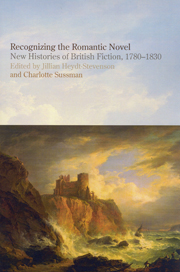Book contents
- Frontmatter
- Contents
- Acknowledgements
- Notes on Contributors
- Preface
- 1 ‘Launched Upon the Sea of Moral and Political Inquiry’: The Ethical Experiments of the Romantic Novel
- 2 Bad Marriages, Bad Novels: The ‘Philosophical Romance’
- 3 Enlightenment or Illumination: The Spectre of Conspiracy in Gothic Fictions of the 1790s
- 4 Burney's Conservatism: Masculine Value and ‘the Ingenuous Cecilia’
- 5 ‘All Agog to Find Her Out’: Compulsory Narration in The Wanderer
- 6 A Select Collection: Barbauld, Scott, and the Rise of the (Reprinted) Novel
- 7 Austen, Empire and Moral Virtue
- 8 Fanny Price's British Museum: Empire, Genre, and Memory in Mansfield Park
- 9 Between the Lines: Poetry, Persuasion, and the Feelings of the Past
- 10 Scholarly Revivals: Gothic Fiction, Secret History, and Hogg's Private Memoirs and Confessions of a Justified Sinner
- 11 Sympathy, Physiognomy, and Scottish Romantic Fiction
- Works Cited
- Index
5 - ‘All Agog to Find Her Out’: Compulsory Narration in The Wanderer
- Frontmatter
- Contents
- Acknowledgements
- Notes on Contributors
- Preface
- 1 ‘Launched Upon the Sea of Moral and Political Inquiry’: The Ethical Experiments of the Romantic Novel
- 2 Bad Marriages, Bad Novels: The ‘Philosophical Romance’
- 3 Enlightenment or Illumination: The Spectre of Conspiracy in Gothic Fictions of the 1790s
- 4 Burney's Conservatism: Masculine Value and ‘the Ingenuous Cecilia’
- 5 ‘All Agog to Find Her Out’: Compulsory Narration in The Wanderer
- 6 A Select Collection: Barbauld, Scott, and the Rise of the (Reprinted) Novel
- 7 Austen, Empire and Moral Virtue
- 8 Fanny Price's British Museum: Empire, Genre, and Memory in Mansfield Park
- 9 Between the Lines: Poetry, Persuasion, and the Feelings of the Past
- 10 Scholarly Revivals: Gothic Fiction, Secret History, and Hogg's Private Memoirs and Confessions of a Justified Sinner
- 11 Sympathy, Physiognomy, and Scottish Romantic Fiction
- Works Cited
- Index
Summary
Mute Eloquence
Brainstorming ideas for The Wanderer; or, Female Difficulties (1814), Frances Burney envisions the plot turning on an impenetrable mystery: ‘A carried on disguise, from virtuous motives, producing a mystery which the audience themselves cannot pierce. Exciting alternatively blame & pity’. The novel tracks the difficulties of a young woman who appears on the scene disguised as a ‘tattered dulcinea’ – a French émigrée wearing the plainest clothes, her face swathed in bandages and patches, and her skin coloured black. Yet the disguise is not ‘carried on’, but falls away so quickly, disappearing within the first few chapters, that it is really immaterial next to the truly unpierceable mystery of the novel: the wanderer's reticence, her stubborn refusal to tell her story. Recent critics have read women's reticence in Romantic novels as the sure sign of psychological depth. In her breathtaking account of the ‘economy of character’ through the eighteenth and nineteenth centuries, Deidre Lynch identifies the Romantic-period heroine as prototypically reticent and plain, her deep psychology in effect produced by the narrative's free indirect discourse, or what is not directly spoken by the heroine herself: ‘One might suppose that the premise that underwrites turn-of-the-century characterization is that declarative sentences do not suit a heroine: they say too much’. Arguing that readers grew accustomed to recognizing such plainness and quietness as the signs of ‘retiring, deep femininity’, Lynch understands ‘depth effects’ to be the fruit of new cultural practices, specifically ‘reorganiz[ing] Romantic-period reading as an experience in exercising personal preferences’.
- Type
- Chapter
- Information
- Recognizing the Romantic NovelNew Histories of British Fiction, 1780-1830, pp. 126 - 154Publisher: Liverpool University PressPrint publication year: 2010



